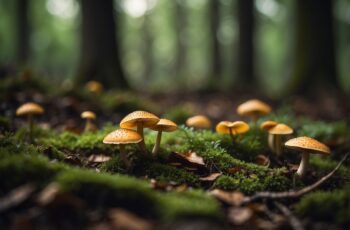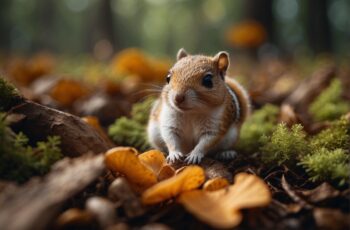Mushroom hunting is an exciting and rewarding pastime that combines a love for nature with the thrill of discovery. Not only do you get to spend time outdoors, but you’ll also have the chance to enjoy the fruits of your foraging labor. This activity can be enjoyed by individuals of all ages and experience levels, making it an ideal hobby for families, friends, or solo adventurers.

To begin your mushroom hunting journey, it’s important to familiarize yourself with the fundamentals of foraging, including identifying edible mushrooms and understanding when and where to look for them. Additionally, being aware of local rights and regulations will ensure a safe and responsible foray into the world of fungi and prevent any potential legal issues.
Key Takeaways
- Mushroom hunting is an enjoyable outdoor activity for people of all ages and experience levels.
- Understanding the basics of foraging and mushroom identification is essential for a successful hunt.
- Be aware of local rights and regulations to ensure a safe and responsible experience. Where to Go Mushroom Hunting Near Me: A Friendly Guide
Fundamentals of Mushroom Hunting
When to Go Mushroom Hunting
Mushroom hunting is an exciting activity that involves searching for edible mushrooms in the wild. It is a fun way to connect with nature and enjoy the outdoors. The best time for mushroom hunting varies depending on the region and the specific types of mushrooms you are seeking. Seasons and weather play a crucial role in determining the growth and availability of mushrooms. For example, morel mushrooms are typically found during spring, while chanterelles are more abundant in the summer and fall months.
Environment Evaluation
To successfully hunt for mushrooms, it is important to evaluate the environment and become familiar with the natural habitats of various fungi species. Some mushrooms prefer specific types of trees or soil conditions, while others grow in damp, shady areas near bodies of water. In any case, it is vital to carefully examine the surroundings, taking note of factors such as south-facing slopes for early season mushrooms, as well as undergrowth, decaying wood, and the presence of other fungi or plants associated with specific mushroom types.
Types of Mushrooms
Familiarizing yourself with the types of mushrooms in your area is a crucial step before heading out on a mushroom hunt. Invest time in learning about the appearance, habitat, and characteristics of edible mushrooms as well as poisonous ones. A comprehensive knowledge of the local mushroom species will not only help you find the ones you’re seeking but also ensure your safety during foraging activities.
Tools Needed
Having the right tools is essential for an enjoyable and successful mushroom hunting experience. A mushroom hunting bag allows foragers to collect and store mushrooms without damaging them, whereas a mushroom foraging backpack provides a practical way to carry all necessary gear, such as field guides, magnifying glasses, and knives. Essential mushroom foraging tools like a sturdy knife for cutting mushrooms at the base, a small brush for removing dirt, and a comfortable pair of gloves for protection are also crucial items in a mushroom hunter’s kit. Finally, consider assembling a mushroom foraging kit with all the essential gear for a successful and enjoyable hunt.
Identifying Edible Mushrooms
Recognizable Varieties
Edible mushrooms come in various shapes and sizes. Among the most popular and easily identifiable types are morels and lion’s mane. Morels have a distinctive, honeycomb-like cap and a hollow stem. Lion’s mane, on the other hand, can be recognized by its unique, white, shaggy appearance, resembling a pom-pom.
Poisonous Varieties
It is crucial to be aware of poisonous mushrooms when foraging. In Indiana, for example, several toxic mushroom species can cause serious harm if consumed. Avoid picking mushrooms that you cannot confidently identify and remember that poisonous varieties can closely resemble edible ones.
Characteristics of Mushrooms
When identifying wild mushrooms, pay attention to their habitat, shape, color, and smell. Edible mushrooms in Ohio, for instance, can be found in various environments like forests, fields, and even suburban lawns. Fungi have diverse characteristics, so it is essential to familiarize yourself with their specific features. Check out guides for your region to learn more about local edible mushroom varieties and their distinguishing traits.
Recommended Locations for Mushroom Hunting

Pacific NorthWest
The Pacific Northwest is a hot spot for mushroom hunting due to its diverse environment and favorable growing conditions. In this region, you can find a variety of edible mushrooms on south-facing slopes and within lush forests. Specifically, areas near Seattle and other parts of Washington are known for their rich fungal diversity. Exploring north of Seattle may yield bountiful mushroom harvests.
Midwest
The Midwest, particularly in states like Indiana and Oklahoma, offers prime locations for mushroom hunting. Indiana is home to a variety of edible mushrooms, making it a popular destination for enthusiasts. For more information on mushroom hunting in Indiana, including tips and best spots, check out this guide. As for Oklahoma, the state’s diverse landscape is conducive to various mushrooms, including the popular morel mushroom. Find useful tips, regulations, and best spots for mushroom hunting in Oklahoma here.
South
Mushroom hunting in the South is an adventure, with states like Georgia and Florida offering numerous possibilities for foraging. Georgia, with its diverse woods and climate, is home to various species of mushrooms, making it an exciting place for experienced foragers and amateurs alike. Meanwhile, in Central Florida, mushroom hunters can find a unique and abundant fungal environment, thanks to the region’s climate and biodiversity.
East Coast
The East Coast, from New York to Virginia, offers a different yet rewarding mushroom hunting experience. New York boasts various forest types and microclimates, providing an ideal environment for different mushroom species. Venturing into the forests of Virginia might prove challenging, but successful hunters can find elusive and rewarding morel mushrooms. To increase your chances of finding morels in Virginia, follow these tips and tricks.
Rights and Regulations

Private Land
When foraging for mushrooms, it is crucial to respect private property. Always ask for permission if entering private land, and follow any rules and regulations set by the landowner. Failing to do so can result in fines or other penalties. By adhering to these guidelines, you are practicing responsible and respectful mushroom hunting. Consider taking a mushroom foraging course to learn more about identifying and harvesting wild mushrooms safely.
State Parks
State parks offer an excellent opportunity for mushroom hunting, with specific regulations depending on the location. Before venturing into state parks to forage, be sure to familiarize yourself with the local rules and guidelines, as they can vary from one park to another. Some parks may require permits or have restrictions on the amount and types of mushrooms you can collect. Joining a mushroom foraging class can provide valuable insights into these regulations and help you become a better forager.
National Forests
National forests also present great mushroom hunting possibilities. Similar to state parks, you need to be aware of any regulations or restrictions that apply within them. Generally, personal use mushroom harvesting is allowed, but commercial gathering may require a permit. Additionally, some forests have designated areas for foraging, so it is essential to consult local resources, such as the use of an onX map, to ensure you are staying within legal boundaries. By following these guidelines, you can help protect these natural spaces and enjoy a rewarding mushroom hunting experience.
Mushroom Hunter’s Guide
Mushroom hunting can be a rewarding and educational outdoor activity, but it’s essential to be well-prepared and knowledgeable about the process. When starting, it’s crucial to familiarize yourself with the types of mushrooms in your area, such as shaggy manes, and invest in a comprehensive guidebook to help with proper identification.
Safety in mushroom hunting is vital, as consuming incorrectly identified mushrooms can lead to severe health problems. To begin, learn and follow sustainable foraging tips to ensure minimal impact on the environment. Always carry a field guide or use a reputable mobile app to help in proper identification of wild edibles while in the field. Additionally, bring necessary equipment such as a basket or paper bag to collect the mushrooms, a knife for cutting, and wear appropriate clothing for the terrain.
When deciding where to go for mushroom hunting, it’s essential to consider the environment and conditions that mushrooms thrive in. For example, morel mushrooms can often be found near the edges of wildfires, in river bottoms close to cottonwoods, or aspen stands. Adjust your search based on local weather and the season as mushrooms have specific growing periods.
A helpful tool when searching for morel mushrooms is a morel mushroom map to help locate ideal habitats. Consider joining local foraging groups, classes, or educational tours to gain knowledge and experience in mushroom hunting. These activities also provide an opportunity to connect with fellow foragers willing to share valuable tips and experiences.
When mushroom hunting, don’t forget to practice patience and be thorough in your search. Keep in mind that some mushrooms might be well-camouflaged or hidden beneath forest debris. Finally, once you’ve successfully foraged your mushrooms, ensure that they are properly stored to preserve their flavor and texture.
Armed with knowledge, appropriate tools, and a keen eye for detail, mushroom hunters can turn their hobby into an enjoyable and vital skill for finding and enjoying wild edible mushrooms in a sustainable and responsible manner.
Frequently Asked Questions

What are the top locations for mushroom hunting in the United States?
Mushroom hunting is popular across the United States, with a variety of suitable locations. Some prime spots include National Forests, State Parks, Private properties, and other locations such as public lands, wildlife refuges, and conservation areas.
When is the best season for finding various types of mushrooms?
The season for mushrooms can vary depending on the type and location. To maximize your chances of finding the best mushrooms, consult a Mushroom Season Chart that details the optimal picking times for various species.
Which states are most famous for morel mushroom hunting?
Morel mushroom hunting is especially popular in the Midwestern United States, including states like Michigan, Wisconsin, Missouri, and Illinois. However, morels can be found in other regions, so it’s important to familiarize yourself with the specific conditions and growth patterns in your area.
Are there any useful resources or maps for identifying prime mushroom hunting spots?
Yes, resources like MushroomStalkers provide mushroom maps and guides that can help you discover the best locations for mushroom hunting in your area. These maps and guides provide information on the growth conditions, host trees, soil types, and other factors relevant to mushroom foraging.
What foraging tips should I consider to maximize my mushroom hunting experience?
To enhance your mushroom hunting experience, follow these guidelines:
- Familiarize yourself with the types of mushrooms in your area and their specific growing conditions, using resources like a Mushroom Season Chart.
- Always carry a field guide or reference material to help with identification, especially if you’re new to mushroom hunting.
- Be aware of the potential risks involved with foraging, such as consuming poisonous mushrooms. Practice proper identification and verify your findings with an experienced forager if you’re uncertain.
- Follow the foraging etiquette, such as not over-harvesting and respecting private property boundaries.
Is it safe to go mushroom hunting in my local area?
Mushroom hunting can be safe and enjoyable as long as you take precautions. Always familiarize yourself with the types of mushrooms in your area, know how to identify them, and be aware of any potential hazards. It’s important to also practice responsible foraging by obtaining permission to access private lands and respecting the environment.


